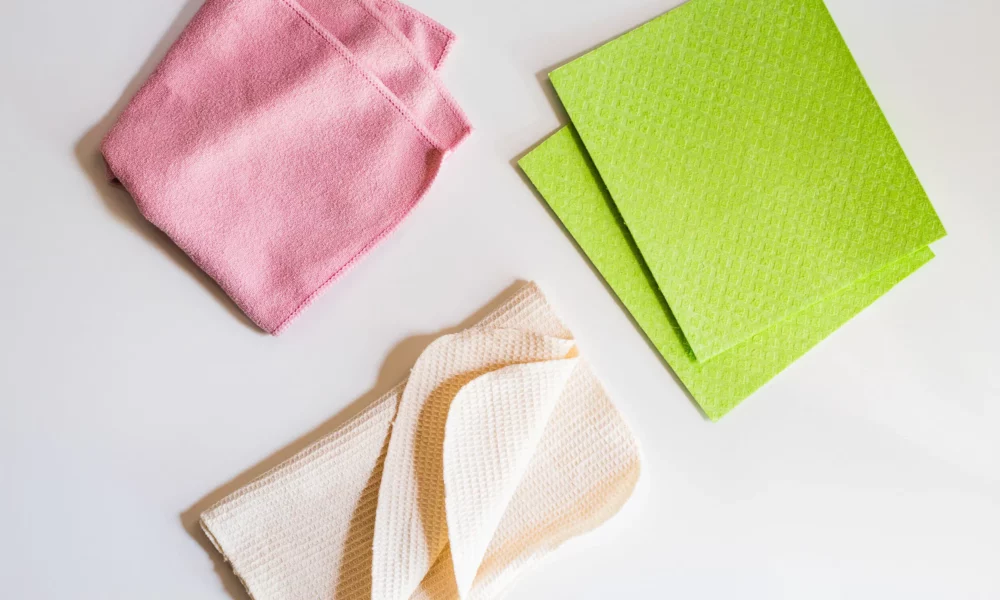What Are The Different Types Of Cleaning Rags?

Let’s start with a definition of rag. Any fiber with a denier of one or less is considered rag (denier is a measurement of fineness equal to a unit of fiber weighing one gram for each 9000 meters). Rag is around 1/100th the diameter of a human hair and 1/20th the diameter of a strand of silk, to give you an idea. An average rag towel has roughly 200,000 fibers per square inch. Rag with a denier of 0.5 or less is often used for cleaning. This provides a large surface area for absorbing fluids or trapping dust and grime.
What is a cleaning rag?
Rag is a polyester and polyamide combination used in cleaning goods (nylon). The fiber is split during the production process in higher-quality cleaning fabrics to create gaps in each fiber. An asterisk would appear if a cross section of split rag was examined. The job is done by the split fiber in combination with the space between them. They collect and retain dust and debris, as well as absorb fluids. Because you don’t want your rag cloths or furnishings to be absorbent, you can’t split lower-quality rag cleaning products.
Is there a variety of rag cloths? Yes, of course! Rag is a cleaning tool, and much like any other chore, cleaning is simpler when you have the correct equipment. There’s a rag specifically developed for washing heavy filth areas like bathrooms and kitchens, as well as dusting fragile mementos.
Cleaning Rag Cloths: What Are They and How Do They Work?
“Do I need various kinds of rags for different surfaces?” is a question we get a lot. The solution is a little more complicated. On the one hand, various varieties of rags aren’t required, just as a chainsaw isn’t required when a manual saw is available. Obviously, a chainsaw will assist you in cutting down the tree more quickly, but a handsaw would suffice. Let’s speak about the many sorts of rag and how this specialized equipment may help you finish your cleaning jobs faster.
All-In-One Cleaner
When you think of a rag towel, you probably think of all-purpose and multi-surface cloths. They’re suitable for a variety of uses and are safe to use on any surface, as their name suggests. They feature a classic terry weave and a large surface area for dry dusting, spill cleanup, and general cleaning.
Glass rag
Glass cloths made of rag are knit rag products. They’re designed to remove smudges and stains off smooth, reflective surfaces like mirrors, windows, computer displays, and even stainless steel. They’re often used as a drying towel after a surface has been cleaned to restore its luster.
Textured rag
Scrubbing and drying jobs benefit from rag cloths with a textured weave, such as a waffle towel. The irregular pattern in the weave helps produce more friction without hurting a surface while scrubbing, allowing you to clean in less time and with less effort. The high-low architecture enables liquid to be taken up in the upper areas of the towel and then wicked away to the lower sections, leaving a drier towel surface.
Polishing rag
Polishing cloths have a greater pile and a weave with a longer knap that is cut than an all-purpose terry weave cloth. The coral fleece rag polishing cloths provide an ultra-plush and silky feel and appearance. They’re designed to apply and remove polishes on fragile surfaces like as autos and metal. They’re great for preserving jewelry and silver in good condition.
What To Look for When Buying a Rag Cloth
Matching the correct tool to the job is the key to selecting the perfect rag cloth. Check out our Selection Pack of Rag Towels if you want to test out a variety of rag cloths before you go out and purchase just any rag towel.
FAQ’s
What are the advantages of rag?
When it comes to cleaning, rag outperforms cotton. A single rag is far smaller than a single strand of cotton, allowing it to take up more dirt, dust, debris, and even pathogens than a single strand of cotton. In addition, it is more absorbent than cotton. It may even save you money since it lasts longer than cotton and remains effective after hundreds of launderings. Rag cleans well on its own, so all you need is water to clean properly; you won’t need as many cleaning chemicals. It also has a longer shelf life.
What characteristics distinguish a high-quality rag towel?
When you run your palm over it, it will feel grippy. As a result, it will efficiently collect dust and filth. Rather of pushing spills along the surface, it will “suck up” them. Stretch the towel while holding it up to the sun to ensure it is thick. It’s not a thick rag towel if you can see right through it like a cheesecloth, and it won’t absorb well or last long. Make sure your towel has a polyester/polyamide combination of 80/20 or 70/30. For those that use rag professionally, these are the most common mixes.
Rag Towels: How to Care for Them?
When washing rag towels, keep these three things in mind: Tumble dry at maximum heat of 140° F. Rag is made up of synthetic components that may melt when exposed to high temperatures. There is no fabric softener! It clogs the rag’s open areas, making the cloth less effective. Rag should only be washed with other rag or non-linting synthetics.
Final words
Now you know a lot about rags . As you can see, there are few different options available to purchase in the market. You will need to take a look at those options and then settle down with the best type of rags that match your purpose. Then you will be able to end up with getting maximum returns that come on your way.





